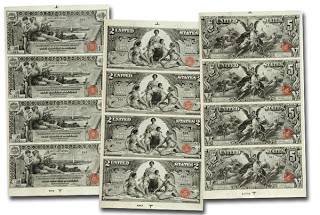
Every collector of banknotes and even coins is generally aware of the artistic treasures that were produced by the Bureau of Engraving and Printing in the late nineteenth century. The three-denomination group of 1896 Silver Certificates was that high point. With all three being encountered with frequency at public sale, these notes still bring lofty premiums when compared with much scarcer, yet less ornate, items of the same quality. Last August Stacks Bowers Galleries had the privilege to offer the pinnacle of available items from this coveted series from the holdings of the late Harry W. Bass Jr. Presented to collectors were three uncut sheets that made up the three denominations. Each sheet, in typical fashion, showed four notes with serial numbers in sequence. Those serial numbers were the exact first to be produced for circulation with numbers 1-2-3-4 adorning the individual notes for each sheet. The sheets were all bound into a beautifully made contemporary presentation album and sold as a single lot. That lot brought an outstanding $1,265,000 and became the most expensive United States Currency lot to be purchased through a public auction.
The five dollar denomination for the 1896 series typically draws the most attention of the three. The note shows an incredible allegorical vignette, which spans the entire face design. The allegory is titled “Electricity Presenting Light to the World.” The note is scarce in high grades and quite rare in Gem states attracting heavy attention from collectors when the latter is offered. Our recent March Baltimore Auction at the Whitman Coin and Collectibles Expo offered such an item. Sold as lot 5559, the Five Dollar 1896 Silver Certificate was among the finest graded by PCGS Currency for the catalog number. Certified as Superb Gem New 67 PPQ, the item showed technical prowess, which trounced all others of lower Gem quality. Picture perfect borders and pristine original paper certainly enhanced the appeal. The note drew significant attention from advanced collectors and realized a record-breaking price for the Friedberg 269 Bruce – Roberts signature variety. At a cost of $43,12, the note broke the previous record (from January 2008) of $37,375 at public sale for the catalog number.
Overall this is a series which I feel inspires new collectors to enter the hobby and will forever remain that way while there is a market for collectible paper money. The series is collected in any budget range with even heavily circulated pieces still showing their designs with great visual prowess. My personal interest in this field is largely due to the One Dollar note from the “Educational,” series, and I always have a fondness for the design every time an example crosses my desk, no matter the grade.





